By John Markwell | Contributing Editor
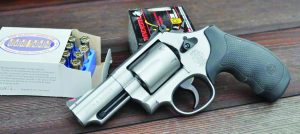
With its satin stainless finish and wraparound polymer grips the new S&W Model 66 is one right attractive and functional revolver.
We have always had a soft spot for Smith & Wesson’s Hand Ejector revolvers. Development of the classic S&W revolver, as we know it today, began in 1894 and upgrades in the design continue to this day. According to Roy Jinks, the K-Frame revolvers have been “the most important development for S&W…and are some of S&W’s most famous revolvers”. The newest Model 66 .357 Magnum revolver, with its 2.75 inch barrel, continues that evolutional tradition and is a great addition to the K-Frame line-up. Whether for field use or personal defense this short barreled revolver is both handy and powerful.
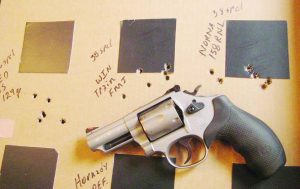
Typically, the Model 66 shot lower than the .357 Mag ammo with the .38 Special loads tested. Zeroing the revolver to a specific load would be easy with the excellent S&W micrometer rear sight.
We have had the .357 Mag Model 66 on site here in the hills for about two months now and it has proven to be an extremely able performer. Like all Hand Ejectors, the 2¾-inch 66 is a 6-shot double-action revolver. It is built from stainless steel and weighs just a hair over 33 ounces.
The hammer, smooth trigger, cylinder latch, ejector rod and rear sight are black; the front sight (which is pinned to the barrel shroud’s rib) is also black with a red ramp insert. The rear sight is the classic S&W revolver sight without white lines on the blade. The six-shot cylinder lacks the recessed case head feature of the older Combat Magnums. The front edge of the cylinder is nicely beveled and the ejector rod, which is solid, is just long enough to clear magnum length cases if given a good rap. Lock-up of the cylinder is accomplished via the traditional method at the rear of the frame window but not at the front end of the ejector rod.
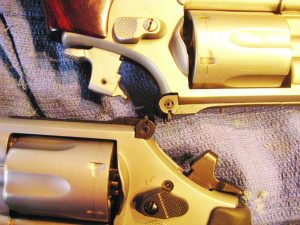
The new Model 66 (below) has a frame mounted firing pin and does not have the firing pin attached to the hammer as does the author’s older M66 (above). Also note the key lock hole on the new, lower revolver.
Similar to the old Triple Locks, the crane is locked in place by a ball-detent incorporated into the frame. The grip frame is the new round butt size/style and comes with nicely textured rubber grips. The 2.75” barrel is a two-piece design with a rifled liner covered by a shroud. Removal of the stainless steel barrel tube requires a special tool available from S&W. Diameter of the shrouded barrel at the muzzle is .770” compared to .670” on our older 3-inch Model “66 River Gun”.
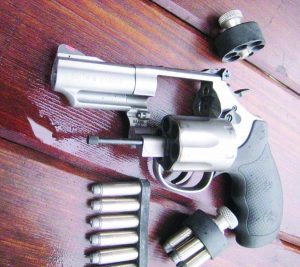
Note the frame mounted crane lock, solid ejector rod and the beveled front edge of the cylinder on the new M66.
Two other notable differences in our old and the new revolver are the frame-mounted firing pin on the newer revolver and its keyed safety lock located just above the cylinder latch. As noted above, the trigger is smooth and .38” wide. The single-action trigger pull weight was 4 pounds 13 ounces and the DA pull was a smooth and glitch-free 10 pounds 8 ounces according to our Lyman digital trigger pull gauge.
Despite the difference in barrel diameters, the new 66 fit our old revolver’s DeSantis holster well enough to be used when out and about on our place here in the hills. Since it was winter here during most of our testing, the 2.75” Model 66 revolver was most often carried concealed under some sort of garment. The rubber like grips, although extremely comfortable in the hand when shooting, were just sticky enough to be problematic for concealed carry, often snagging on whatever cover garment was being worn. If we were to keep this revolver for concealed carry purposes a pair of Craig Spegel’s Boot grips would be installed.
Smith & Wesson Model 66, 2.75” barrel, velocity and accuracy
Ammunition Vel. (fps) 20yd. acc.
.357 Magnum
CorBon125-gr. DPX 1281 2.65”
Handload: 147gr Speer
¾ jacketed SWC HP, 7gr/W231 1097 2.75”
.38 Special
Win. Training load 130gr FMJ 758 2.50”
Norma 158gr RNL 75 3.65”
Federal 129gr HS +P 816 2.25”
We shot this new .357 Magnum wheel gun with both .38 Special and .357 Magnum ammunition. The 38 Special loads were: Winchester’s Training Load featuring a 135-grain FMJ bullet, Federal’s 129-grain +P JHP and a plain vanilla 158-grain round nose lead load from Norma. We only shot two .357 Magnum loads: CorBon’s 125-grain DPX load and our old standby handload for our old 3” 66 using the now defunct Speer 147-grain jacketed SWC HP bullet over 7 grains of Winchester 231. All loads were grouped at 20 yards, from a bench rested position over bags, and chronographed 10 feet from the muzzle. Ammo wise, the 2.75” Model 66 had a preference for .357Mag ammo over 38 Special. It shot the .357 CorBon 125-grain DPX load especially well (better than we can normally shoot groups in fact) often putting four or five shots into groups measuring around an inch and a half with a fifth and/or sixth shot flyer (most likely shooter induced) enlarging the groups to over two inches. Bear in mind we had one of those really good days testing this revolver for accuracy as we have never been known for shooting great groups with a handgun. See the chart for the data.
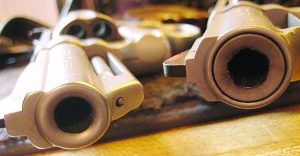
The old style solid barrel (left) as compared to the two piece barrel of the new Model 66.
The Model 66 performed flawlessly during all of our shooting sessions, be it range work or plinking in the field. We had some initial concerns about the length of the ejector rod but, as mentioned above, it proved to be long enough to positively eject fired cases. We did notice that the edges of the cylinder’s chambers were a bit sharp and working with speed loaders or speed strips often required a bit of fiddling. Were we to keep this revolver we would chamfer these edges slightly to facilitate quick and glitch-free loading. Also, there was initially a bit of stickiness in the opening and closing of the cylinder. This smoothed out with use over the month or so we had the gun.
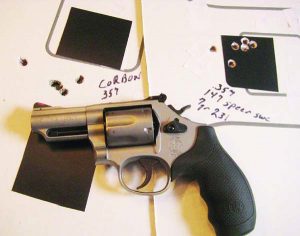
These were pretty typical of the test groups fired from the Model 66 with .357 Magnum ammunition at 20 yards. The author admittedly had a better than typical day when grouping the new revolver.
If we didn’t have our old 3-inch 66 we would be seriously considering keeping this newer Model 66 from S&W. Being stainless steel, this revolver would make a great field piece or “River Gun.” In fact, with only the addition of a set of low profile non-snagging stocks, this 2.75” revolver with its good double-action trigger pull would also make a great concealed carry gun. Carrying the revolver at the 4 o’clock position in our old DeSantis pancake holster was quite comfortable and, with a weight almost the same as a full-sized steel 1911, the short-barreled Model 66 was not burdensome in the least. Built on the solid legacy of the Combat Magnums of the past, this is a robust and accurate revolver that should serve users long and well. Packed in a nicely padded blue plastic case, this new rendition of the Model 66 .357 Magnum revolver with its 2.75” barrel has a street price of $800 plus or minus a few bucks. Good shooting.



